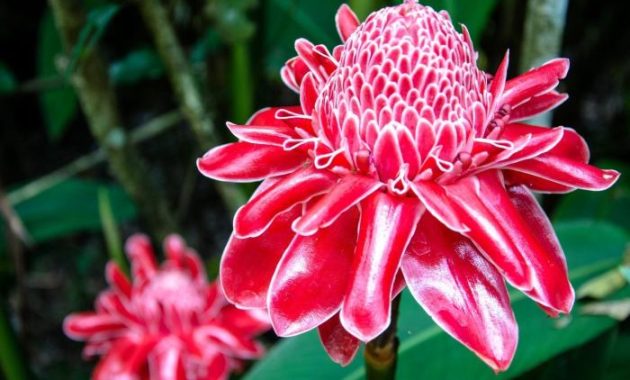Plant Identification and Characteristics

Pink flowering ginger plants, members of theAlpinia* genus, boast a captivating array of vibrant hues and elegant forms. Understanding their diverse characteristics is key to appreciating their beauty and successfully cultivating them. Their visual appeal stems from a combination of striking foliage and flamboyant blooms.
Pink flowering ginger plants exhibit considerable variation in size and appearance depending on the specific variety. Generally, they are herbaceous perennials, meaning they die back to the ground in colder climates but regrow from their rhizomes in spring. Their leaves are typically lanceolate, meaning they are long and pointed with parallel veins, often exhibiting a rich, deep green color.
The leaves themselves contribute significantly to the overall aesthetic, creating a lush backdrop for the stunning inflorescences.
Pink Shade Variations
The spectrum of pink found in these plants is remarkably broad. Some varieties showcase delicate pastel pinks, reminiscent of a blushing sunrise, while others display bold, intense magenta shades that command attention. The intensity of the pink can also vary depending on factors such as sun exposure and soil conditions. For example, plants grown in partial shade might exhibit a softer pink than those basking in full sun.
This natural variation contributes to the unique charm of each individual plant.
Behold the pink flowering ginger, a flamboyant spectacle of nature’s artistry! Its vibrant blossoms demand the sun’s ardent embrace, thriving under its golden gaze. To truly unleash its fiery potential, consider the best flowers to plant in full sun , a guide to selecting companions worthy of this radiant queen. Indeed, the pink flowering ginger, a sun-worshipping diva, deserves nothing less than the sun’s full, unwavering attention.
Comparison with Similar Plants
Distinguishing pink flowering ginger from similar-looking plants requires careful observation. Several other ginger species and even some unrelated plants share a superficial resemblance. However, key differences lie in leaf structure, flower shape, and overall plant habit. For instance, someCostus* species (spiral gingers) might possess similar inflorescences, but their leaves typically have a more pronounced spiral arrangement and a different texture.
Careful examination of the flower structure, specifically the arrangement of bracts and the shape of individual florets, will often reveal the true identity of the plant.
Pink Flowering Ginger Varieties
| Variety Name | Flower Color | Height (approx.) | Notable Features |
|---|---|---|---|
| Alpinia zerumbet ‘Variegata’ | Pale Pink | 6-8 feet | Variegated leaves with creamy-white stripes |
| Alpinia purpurata | Deep Pink to Reddish-Pink | 3-6 feet | Showy, brightly colored bracts surrounding the flowers; often used in floral arrangements. |
| Alpinia officinarum (less common pink forms) | Light Pink (occasionally) | 6-10 feet | Known primarily for its culinary use (galangal); some forms may exhibit pale pink flowers. |
| Alpinia bruekneri | Various shades of pink | 4-6 feet | Often displays a more compact growth habit compared to other Alpinia species. |
Uses and Applications

Pink flowering ginger, with its vibrant blooms and lush foliage, offers a multifaceted array of uses extending beyond its undeniable aesthetic appeal. Its applications span ornamental landscaping, potential medicinal uses, and even hold cultural significance in various parts of the world. This section delves into the diverse ways this captivating plant is utilized.
Ornamental Uses in Landscaping and Gardening
The striking beauty of pink flowering ginger makes it a highly sought-after plant for landscaping and gardening purposes. Its vibrant pink flowers, often complemented by attractive foliage, provide a stunning visual impact in various garden settings. It thrives in shady areas, making it ideal for underplanting larger trees or creating a vibrant backdrop in woodland gardens. Landscapers often utilize its clumping habit to create dramatic borders or to add texture and color to mixed flowerbeds.
The plant’s height and spread can be strategically managed through pruning to fit various design schemes, from formal to informal gardens. Its tolerance to shade and moist conditions also makes it a suitable choice for areas that are challenging for other flowering plants.
Medicinal and Culinary Applications
While research on the medicinal properties of pink flowering ginger is still ongoing, some traditional uses suggest potential therapeutic benefits. In certain cultures, parts of the plant have been employed in traditional medicine for their purported anti-inflammatory and analgesic properties. However, it’s crucial to emphasize that these are traditional uses and not scientifically validated treatments. Further research is needed to confirm and understand the full extent of any potential medicinal applications.
Concerning culinary uses, pink flowering ginger is not widely utilized as a culinary ingredient in the same way as other ginger species. Its primary use remains largely ornamental.
Cultural and Symbolic Significance
The cultural and symbolic significance of pink flowering ginger varies across different regions and cultures. In some parts of Southeast Asia, where the plant is native, it may be associated with prosperity, beauty, or good fortune. Specific meanings often depend on local traditions and beliefs. The vibrant pink color itself frequently carries positive connotations, symbolizing love, joy, and vitality in many cultures.
The lack of widespread, documented symbolic associations suggests further research into the cultural contexts surrounding this plant is warranted.
Applications Summary
| Application Type | Description |
|---|---|
| Ornamental Landscaping | Used extensively in gardens and landscaping due to its attractive pink flowers and foliage. Ideal for shade gardens, borders, and mixed flowerbeds. Its clumping habit and manageable size allow for versatile design applications. |
| Potential Medicinal Uses | Some traditional uses suggest anti-inflammatory and analgesic properties, though scientific validation is required. Further research is needed to confirm these claims. |
| Culinary Applications | Limited culinary use compared to other ginger species; primarily used for ornamental purposes. |
| Cultural Significance | Symbolic meanings vary across cultures; often associated with positive connotations such as prosperity, beauty, love, and vitality in various regions, particularly in Southeast Asia. |
Visual Representation: Pink Flowering Ginger Plant

The pink flowering ginger, with its vibrant hues and unique form, offers a captivating visual spectacle in any garden setting. Its aesthetic contribution extends beyond mere ornamentation; it introduces a dynamic interplay of color, texture, and shape that elevates the overall garden design. The plant’s visual impact is multifaceted, ranging from its individual flower structure to its contribution to the larger landscape composition.The visual appeal of pink flowering ginger stems from a harmonious blend of color, texture, and form.
The flowers themselves boast a range of pinks, from delicate blush tones to deep, almost fuchsia shades. These colors are often intensified by the contrasting green of the foliage, creating a visually striking juxtaposition. The texture of the flowers, often described as soft and velvety, adds another layer of sensory appeal. The overall form of the plant, with its arching stems and clustered blooms, contributes to its graceful and elegant appearance.
This elegant form creates a sense of movement and fluidity within the garden, a visual counterpoint to more structured plantings.
Pink Shade Variations in Garden Design, Pink flowering ginger plant
Different shades of pink in a garden setting evoke distinct moods and aesthetics. Lighter pinks, such as blush or rose, create a sense of serenity and gentleness. They blend well with pastels and other soft colors, producing a harmonious and calming effect. In contrast, deeper pinks, like fuchsia or magenta, add a vibrant and energetic touch. These bolder shades command attention and can be used as focal points within a garden design, complementing richer jewel tones or creating a striking contrast against greens and blues.
The strategic use of varying pink shades within a planting scheme allows for the creation of depth and visual interest, preventing monotony and enhancing the overall aesthetic impact. For instance, a border of lighter pink ginger could gently frame a bed of darker pink roses, creating a subtle yet effective color gradient.
Visual Integration in a Garden Scene
Imagine a lush, tropical-inspired garden where a cluster of pink flowering ginger plants nestles amongst other foliage. The ginger’s vibrant pink blooms provide a stunning contrast to the deep green of hostas with their large, heart-shaped leaves, creating a visually striking focal point. The arching stems of the ginger gracefully intertwine with the more upright forms of the canna lilies, their fiery orange blooms complementing the pinks in a lively and dynamic display.
Further softening the scene are the delicate, cascading fronds of a maidenhair fern, adding a layer of textural interest and visual depth. The overall effect is a vibrant and harmonious blend of colors and textures, where the pink flowering ginger plays a crucial role in unifying the various elements of the garden design. The interplay of light and shadow on the flowers throughout the day adds yet another dimension to the visual experience, highlighting the subtle variations in the pink hues and the velvety texture of the petals.
The ginger’s elegant form creates a sense of movement and life within the garden, making it a truly captivating feature.
FAQ Guide
Is pink flowering ginger fragrant?
Yes, many varieties possess a pleasant, often spicy fragrance, though the intensity varies.
How long does a pink flowering ginger bloom last?
Individual flowers may last only a few days, but the plant will continuously produce new blooms over several weeks or months, depending on the variety and growing conditions.
Can pink flowering ginger tolerate frost?
No, pink flowering ginger is not frost-tolerant. It thrives in warm climates and requires protection from freezing temperatures.
Are there different sizes of pink flowering ginger plants?
Yes, varieties range in height from a few inches to several feet tall, depending on the species and growing conditions.

